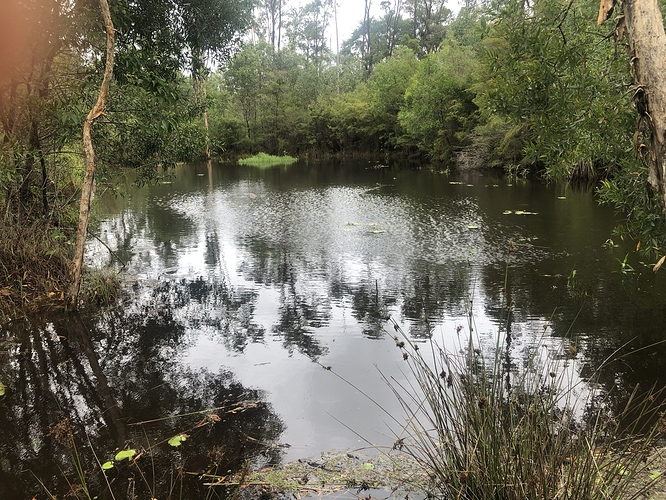A couple of articles to help the category “grow”.
Some more articles.
Always ensure the head gardener is kept busy.
- Raking up leaf litter and mulching are labour consuming.
- Around the more rural home heavy accumulations of litter can add to the fire hazard. Now it’s all in one useful pile.
Anything within 50m of the mound is useful.
That this guy and his girlfriends have been at it since June is uncommon. More a Sept to Dec romance. They’ve been dating here and passed the same mound down through the generations for at least 20 years. Perhaps they noticed something different about the climate this winter?
Rain. Many Australian animals breeding cycles, including birds, are triggered by rain and resulting plant growth. Rain brings bounties of food which can support the raising of the next generation and the success of the species.
For some but not all?
The local climate June to Nov are typically the driest months of the year. Our norm is for the turkeys to breed and mound in spring when everything has been dried and crisped by the cold westerly winds in August. Rain is a rare event. Once the summer sub tropical rains turn up the gardening stops. The flowering cycles of the local melaleucas, and our 3 species of acacias have not altered either.
Perhaps the turkeys know something about the coming spring and summer that has encouraged the early winter romancing.
It’s all about the garden though and living with the turkeys. We have other gardeners who deliberately set out their piles of weeds near to a mound. ![]()
They soon disappear. The regular turning on the mound seems to manage any germination concerns. I’ve avoided planting anything too precious within range. Tree guards and plastic mesh work. Once established the turkeys seem to respect the plant is a future donor of leaf litter.
It is the lead up period. Australia has experienced a wetter than average summer and autumn due to a La Nina event. The additional rains over this period would stimulate/trigger breeding as often it takes trees, shrubs and grasses months to set seeds/fruit. With rain, more seed/fruit is set. The breeding cycle will be triggered by more abundant foods from the rain over the past 6 months.
True for SE Australia, but not for SE Qld which is a different weather zone. I had a quick check. The median rainfall for the first half of the year here is 89cm rounded. Approx 100 years of data.
The first 6 months of this year are just over 90cm which has fallen in the usual pattern of wettest in Jan-Mar tapering off into June.
I can’t quite vouch exactly for the stats. The BOM regional weather station is 7km down the road.
I’m not drawing any conclusions, other than sharing some gardening love, and wondering if others have noticed in their gardens a different winter on the east coast?
Which has stimulated a breeding cycle. This BOM map on rainfall anomalies shows most of the east coast has average to above average rainfall. There are a few pockets with average to slightly below average…
Similar trends exist for 5-7/8 months…seven/eight months being around the start of the summer rains.
Good rainfall stimulates the commencement of breeding cycles as outlined above.
Most gardeners will also notice changes…grass greener and requiring more regular mowing compared to drier years, flowering of natives resulting in more seed/fruit set, birds more active making nests in trees/shrubs, more insects/pest insects/plant diseases, possibly more leaf loss due to increased vegetative growth, wetland areas flourishing with growth and wildlife etc. This is common in seasons where there has been good rainfalls.
In relation to wetlands, an amazing phenomenon is the filling of lakes in the Eyre and Murray-Darling Basins. Wildlife (particularly birds) travel hundreds, if not thousands of kilometres knowing these lakes are filling, to fulfil their own breeding cycles. A spectacle to see…and amazing that they know the lakes are filling…and science is yet to conclusively prove how they know.
Yes, and our place is right on the cream to pale green coloured rainfall boundary. IE About average. Qld and the greater Sunshine Coast.
I guess we will need to agree that Tasmanian birds and brush turkeys breed different to the ones up here. Ours don’t follow the rain cycle. Our locals align to the approach of spring, after a typically dry and cold July - August. I don’t think it is anything to do with the rain pattern which is spot on normal. If it’s a food cycle, mid-winter is not the best time to seek out a good feed.
Having lived in SE Qld, I know the brush/bush turkeys well. Rain triggers their breeding cycle and they can go ‘crazy’, especially rain after a dry spell like that which occurred last year…see…
They will breed any time of year if the conditions are good… see…
Jerry Coleby also provides some things to try if scrub turkeys prove to be a nuisance in the garden. It is also worth noting they are native wildlife, and are protected under the Queensland Nature Conservation Act.
Mirrors set at their viewing level are pretty good at dissuading the Males from doing their nest building in an area. We have found this to be the most successful means. As the birds are Traditional tucker there is an another option if a person is Indigenous, however as they keep the yard really clean if left alone it seems usually unnecessary to interfere with them.

